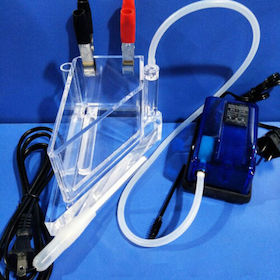
-----
Removing/freezing excess carbonate from cyanide silver plating tanks
⇦ Tip: Readers want to learn from your situation;
so some readers skip abstract questions.
Q. How to extract carbonate of silver cyanide solution.
Naji BaroudElectro plating - Beirut
June 26, 2021
A. Hi Naji. That seems to be the subject of this whole thread and its 50 postings --so more words please, so that we can understand where the difficulty lies.
Luck & Regards,

Ted Mooney, P.E. RET
Striving to live Aloha
finishing.com - Pine Beach, New Jersey
Ted can be retained for immediate
answers or long term project help
⇩ Related postings, oldest first ⇩
Q. I am trying to find out what salts can be successfully used to precipitate excess potassium carbonate from a silver plating bath based on cyanide. Any tips are appreciated.
Jancie HatcherGA Pollution Prevention Asst. Div.
1996
A. Hi Jancie. Carbonates should not be completely removed, but reduced to about 4 ounces/gal (30 g/l).
A proprietary salt for this purpose is 'Decarbonator Salts' available from, for example, W. Canning plc, Birmingham, UK. They are added at a ratio of 1.8 parts by weight for each part of potassium carbonate to be removed. Generic calcium or barium salts can also be used, but I don't have the hands-on knowledge of this to offer specific instructions or points to watch out for (perhaps a reader who silver plates will help us out?)

Ted Mooney, P.E.
Striving to live Aloha
finishing.com - Pine Beach, New Jersey
Ted can be retained for immediate
answers or long term project help
Reducing carbonate level in silver plating tank with calcium nitrate, barium cyanide, or calcium hydroxide
Q. I have a silver tank which has an excessive carbonate level. This tank is made using potassium carbonate which cannot be readily removed from the tank by freezing out due to its solubility in water. I want to add calcium nitrate in small maintenance additions to lower the levels. Does anyone know the effects of the added nitrates and at what level nitrates cause problems with coating deposition?
Robert Kestler- Cherry Point, North Carolina
1996
A. We operate a 40 gal silver cyanide plating bath and had run into carbonate build up in the past. We eliminated the carbonate problem by not returning dragout to the tank and keeping the tank at 70 °F.
I checked our files and found a letter from Arthur Kushner from the Joseph B Kushner Electroplating school. The letter states "...carbonates can be removed from your silver bath by treating with any of the following materials: calcium nitrate, barium cyanide, calcium sulphate, calcium hydroxide, calcium cyanide. If you cannot find the details on these methods, give me a call. " (signed Arthur Kushner) That's all I have. MBK
A. Since I am quoted, I thought I might as well get involved. The whole idea is to remove the carbonate from the silver plating bath. Potassium carbonate is fairly soluble in water (compared to sodium carbonate) so freezing out does not work. Materials such as calcium nitrate, barium cyanide, etc., will react with the potassium carbonate in the plating solution to give you a relatively insoluble carbonate. For example, barium cyanide will react with potassium cyanide to give you barium carbonate and potassium cyanide. Two ounces of barium cyanide will remove about 1.5 ounces of potassium carbonate and reform about 1.25 ounces of potassium cyanide.
A word of caution here. It is a good idea to have some recent analyses of your tank so know where you "are" with regard to cyanide and carbonate concentrations. Test a small batch of your plating solution before charging ahead with the whole tank.

Art Kushner
Anaheim, California
Q. We recently did this treatment on a 600 liter silver tank, using Calcium Hydroxide, which is cheapest, but found that the volume of "sludge" produced was large. Additionally we seemed to lose about 10% of our solution. If the sludges are allowed to stand, the solids settle out and solution becomes recoverable from the top. 4 months after treatment we are still recovering solution from the top of the sludges, at present about 100 ml. per day.
The process vendors always recommend high levels of potassium cyanide, up to 150 ml/liter for a silver content of 20 gms/liter. We feel this accelerates carbonate build up, and try to work with a maximum 120 g/L KCN.
Is there any way to recover the solution more quickly?
- Capetown, South Africa
1996
A. We tried the calcium hydroxide precipitation of potassium carbonate in a silver plating bath. The resulting sludge is excessive. Rinsing the sludge several times with some water helps to recover some of the bath. The hydroxide content increases dramatically, but luckily seems to have no deleterious effect on the baths performance. Lately, we have employed a flow through centrifuge as a means of dewatering the resulting sludge. Our recovery of the plating bath has greatly improved.
Marjorie Turton- Winnipeg, Manitoba, Canada
2000
Q. We have high potassium carbonate content (about 15 oz/gal) in our silver cyanide bath. We try to bring it down to around 5 oz/gal level. Potassium carbonate, having high solubility, cannot be frozen out like sodium carbonate. Another alternative, as we found out, is to precipitate it out using calcium nitrate. We estimate the amount of calcium nitrate needed to be hundreds of pounds since we want to drastically reduce carbonate. How would this sudden surge of nitrate affect the silver bath? we were told some nitrate content( we don't know how much) is beneficial to the bath. But would this be true in our case? If the nitrate content is not a problem, then what grade of calcium nitrate can a silver bath tolerate to minimize the cost of treatment? Is the agricultural grade acceptable( which is the cheapest available), or are we being too greedy? Can anybody suggest the better ways? How about proprietary products? Any comment would be greatly appreciated.
Jeff HuhOakland, California
1999
A. Dear Jeff, It is very difficult to eliminate potassium cyanide in silver bath. But you can use Barium cyanide (BaCN) but this is very expensive method. That is cheaper to remove a part by the bath and preparing to full volume. Regards, Anders

Anders Sundman
4th Generation Surface Engineering
Consultant - Arvika,
Sweden
A. I believe what you need is barium hydroxide. I don't have the recipe handy, but it works quite well to lower carbonate levels in silver cyanide plating baths. It is best to treat and then filter the tank before using again.
Phil Pace- Tulsa, Oklahoma
A. Jeff and Phil I think Barium hydroxide is wrong. When you reduce potassium cyanide the only way to do it is use Barium cyanide and after you have filled the tank with Barium cyanide you must freeze the solution and the carbonates be some ice over the silver bath. Pump the bath from the bottom. But again it is cheaper to reduce carbonate from potassium cyanide by dumping some gallons of silver bath and restoring it to the right parameters. Regards, Anders S.

Anders Sundman
4th Generation Surface Engineering
Consultant - Arvika,
Sweden
A. Jeff: We have been very successful using slaked lime (calcium hydroxide) and barium hydroxide to reduce our carbonate levels in our potassium cyanide silver bath.
Daniel Bemenderfer- Indianapolis, Indiana
1999
Q. Daniel
When you say you used slaked lime & barium hydroxide, did you use them as a mixture, or did you try them separately? And what effect did this have?
Thanks
Mark.
- England
2000
Q. I have been plating for twenty years now. I have been mostly in the electronics industry plating industry. Acid copper,acid gold ,acid tin-lead and so on. I am now plating parts ( new job ) in a copper cyanide and silver cyanide (captive shop). Most parts are aluminum and a small percentage of brass. My question is. The silver cyanide bath. My potassium carbonate is now at 18.2 oz/gal. I know that it naturally happens in the silver cyanide bath by reading text. The company's procedure is to add 10 lbs. of calcium nitrate to the 210 gallon tank to treat the carbonate. The procedure states that 2 oz of nitrate will remove approximately 1 oz of carbonate(is this accurate). I guess what I am asking is can I add more than 10 lbs of nitrate to the 210 gallon of silver cyanide bath so I can speed up the process of removing some of the carbonate. I know that about 4 oz. of potassium carbonate is an ideal range.I know that this process needs to be repeated several times also. Freezing it out is out of the question. The plater that used to plate at the company that I am currently at is no longer here and took everything with him(in his head). Procedures are not real detailed.Any help will be greatly appreciated.
Doug WigginsPlating shop employee - Camden New Jersey
2007
A. Hello Doug,
I would hate to see you add 300 plus pounds of calcium nitrate to your tank at one time. I would seek out the advice of your silver supplier. Yes, you can add more than 10# at a time to the tank. I have not ever had to reduce potassium carbonate that much in any bath. Apparently your predecessor did not take too much with him if he let the carbonate level get that high! You may have to break the treatments up into 3 series. Sorry, but some 800 troy oz of silver is too expensive to play with. Good Luck!
Process Engineer - Syracuse, New York
Q. Why are carbonates used in electroplating?
Why do they put carbonate into a silver cyanide plating bath?
Andy Chan- Hong Kong
2001
A. Hi Andy.
When you put a little carbonate in a silver solution, this carbonate will get the solution a higher leading capability in the silver solution. But then the solution used you will get a higher carbonate because potassium, or if you use sodium cyanide dissolves as a carbonate in the solution as a contamination.
The carbonate is in a new solution about 15 g/l. If the carbonate is more then 120 g/l you should dump approximately half on your solution, and make addition to the right level. You can't freeze potassium cyanide (carbonate) out from the solution because this is very expensive, but if you use sodium cyanide (carbonate), it's no problem to freeze it out.
Regards,

Anders Sundman
4th Generation Surface Engineering
Consultant - Arvika,
Sweden
A. Text books say that it is to buffer at high pH.
Yashawant Devalelectroplaters - Pune, Mah, India
2001
Andy and Yashawant.
Yashawant is also right but carbonate helps to get a pH over 10 in the solution.

Anders Sundman
4th Generation Surface Engineering
Consultant - Arvika,
Sweden
2001
Dumping part of bath may be best
Q. We have problem with carbonates in Silver plating bath. Carbonate is more 150 g/L. To remove Carbonate we're using Calcium nitrate for bright silver tanks, and Calcium sulphate for flat silver tank.
Mr. Anders Sundman recommends dumping approximately half of solution if the carbonate is more the 120 g/L.
Can you give me general information, what is this procedure based on, source for this information, because is very expensive and I need to have good argument to make the procedure.

Benigna Skorobogatiene
electrical components mfgr. - San Jose, California
2001
A. Hi Benigna.
Why I propose to dumping approximately half of your solution is because it's very expensive to freeze carbonates out from silver solution. If you use potassium carbonates. It's only barium cyanide who can remove carbonates from a potassium cyanides silver solution. But if you use Sodium cyanide in your silver solution you can remove the carbonates. A high carbonate it's a contamination in a silver solution the solution will lose the current effectivity and you get dark deposit. The solution will also be black.
Regards,

Anders Sundman
4th Generation Surface Engineering
Consultant - Arvika,
Sweden
Decarbonator for silver plating baths
Q. We are Bombay based Electroplaters doing 5 and 10 Micron Silver Plating on Copper Rollers for L & T.
We need Decarbonators for reducing the carbon in the Silver plating baths, due to which the efficiency of the bath is reducing.
Kindly suggest the possible method to solve the problem.
Thanks & regards,
KIRAN ELECTROPLATERS - Mumbai, MAHARASHTRA , India
2005
A. A bit of an English problem on part of your request. Your problem is carbonate, not carbon. A silver bath that uses sodium cyanide and sodium hydroxide can freeze out carbonates on a very cold coil or possibly a cold finger (if you are a chemist). The solubility of sodium carbonate is that in a cold tank with a near freezing coil or similar apparatus, sodium carbonate crystals will form and temporarily stick to the cold device because you have reached a point beyond the saturation point. This does remove a small amount of trapped bath chemicals, but not bad. The coil is needed as if you just precipitate it out, the flow rate of filtration and the rising temperature will redissolve it. Metal finishing vendors sell these things.
This does not apply for a potassium based bath because the much higher solubility of potassium carbonate at any temperature. For this you are going to have to bail out part of the tank--Not cheap.
- Navarre, Florida
A. The Canning Group markets some "decarbonating salts" which I think are some type of barium salt. The use of them is detailed in The Canning Handbook.
It involves simply adding the prepared salts to the solution and leaving for a set length of time. The carbonate is then precipitated out and the solution can be pumped off the top and filtered and reused. We regularly use this method to decarbonate our silver bath.
- derby, U.K.
A. Years ago JWI offered for sale a unit to remove potassium carbonate from plating solutions, I believe the equipment was made in Europe, it was quite expensive at the time. I'm wondering if it is still available.
Walter Lydick- Jackson, Mississippi, USA
November 27, 2011
A. Hi!
You can find appropriate equipment on internet, if you "Google" it with key-word "carbonate removal"!
- Kranj, Slovenija (EU)
Better to switch to sodium cyanide?
Q. We are an aerospace related silver plating shop that primarily plates aircraft parts. We currently use a potassium cyanide based silver plating solution. The bath size is 94 gallons. We would like to switch to a sodium cyanide based silver plating solution that would enable us to freeze out the carbonates.
Is this a viable idea? Has anyone else done this successfully?
If so, how long does the solution last and what is the composition of the solution makeup?
Are there any references that anyone can tell me about that use a sodium cyanide based makeup for silver plating?
Standard Aero - San Antonio, Texas
2006
A. Short of reclaiming the solution and starting over, I have never read of a way to do it. Literature indicates that the potassium salt plates slightly better than the sodium. You could make all of your future adds with sodium rather than potassium and eventually it would be mostly sodium, but I suspect that your need is now.
James Watts- Navarre, Florida
A. Hi Max,
You can still freeze out carbonates from a potassium cyanide based bath. The carbonates can also be reduced by adding calcium nitrate to the solution. Your silver supplier can give you this process. Sodium cyanide silver solutions are not really used that much in the US anymore. personally, I prefer potassium cyanide based baths. I feel they are easier to work with. Good Luck!
process engineer - Malone, New York
What do we do with the carbonates we've removed?
Q. After removing the carbonates from the cyanide solution, what is the best way to dispose of them?
W Morseemployee - Northwood, Ohio
October 29, 2009
A. Hi, W. They would seem to me to be an F006 plating sludge, which must be disposed of as hazardous waste.
Regards,

Ted Mooney, P.E.
Striving to live Aloha
finishing.com - Pine Beach, New Jersey
Ted can be retained for immediate
answers or long term project help
October 29, 2009
Carbonate removal process isn't working
Q. Hi
We are actually trying to remove the carbonates from our silver tank with calcium hydroxide. The actual concentration in carbonates is 120 g/L. Doing tests in the lab, the concentration after treatment went down by only 5 g/L which is far from the 75 g/L we're trying to achieve. We've put 50 g of calcium hydroxide in 1000 ml of solution and we let it agitate for 4 hours. Any idea why the precipitation is not happening?
Any help would be greatly appreciated.
- Vaudreuil-Dorion, Quebec, Canada
November 18, 2010
A. Hi, Jean-Claude
I believe that freezing only works on sodium cyanide based plating baths, not on potassium based baths. What is the sodium v. potassium situation with your bath?
Regards,

Ted Mooney, P.E.
Striving to live Aloha
finishing.com - Pine Beach, New Jersey
Ted can be retained for immediate
answers or long term project help
Q. Hi Ted
First thank you (1 year later) for the answer. Our baths only contain potassium. We are now successful with lowering the carbonates with calcium hydroxide (from 135 g/L down to 30 g/L) but are worried about the new level of hydroxide (120 g/L). Those results were obtained in lab and we are actually conducting Hull Cell
⇦ huh?
s on the solutions. My question is actually "Have we just changed one problem for another?"
Thanks for your help
- Vaudreuil-Dorion
November 2, 2011
Hi, Jean-Claude.
That's a question I can't help with, but maybe another reader can.
P.S.: Don't feel bad about the delay. The threads are not solely about offering concurrent help to the inquirer, they are also about building reference material for the silent majority who read the postings but don't post themselves due to employer restrictions or other reasons.
Regards,

Ted Mooney, P.E.
Striving to live Aloha
finishing.com - Pine Beach, New Jersey
Ted can be retained for immediate
answers or long term project help
November 3, 2011
A. You can use Barium Nitrate to remove Potassium Carbonate from Silver plating solutions. To reduce one gram of Potassium carbonate in the solution add 1.8 grams of Barium Nitrate. Mix well leave for settling 24 hours and then filter it. There is no side effect on the bath. It is not altering any bath composition. Only removes the carbonate. First do it in 5 liter solution in the lab. Do a hull cell. Test the potassium carbonate level reduced in the solution.
Wish you all the best.
- Auckland, New Zealand
February 18, 2012
Calculations to minimize hazardous waste
Q. I am getting ready to complete a reduction of Carbonate to our 40 gal Silver Plating solution. The bath is a potassium cyanide based solution. Our current analysis shows 11.72 oz/gal of Potassium Carbonate. The desirable amount of 2-4 oz/gal of Potassium Carbonate is the ultimate goal. I have read this thread among others through this site. My understanding is using Barium Nitrate for the reduction is the best albeit the most costly way to achieve our goals.
My question is when calculating the addition of Barium Nitrate 1.8 grams is this in grams per liter? If so I am calculating roughly 18 grams for the desired results.
Also does anyone know how to calculate the amount of 'sludge' which will be produced? We are trying to mitigate the amount of hazardous waste we need to properly dispose of and wish to get my ducks in a row before starting this venture.
Cheers from Colorado
plating shop - Denver, Colorado
September 7, 2012
A. The best, and quite possibly least expensive way to accomplish this is to send your old bath to a reputable refiner who will pay you for the silver, and then build a new bath, using just enough of the old bath to have an initial carbonate of about 1 oz/gal.

Jeffrey Holmes, CEF
Spartanburg, South Carolina
A. Heather,
I agree with Jeffrey that a part replacement is probably the best answer. But I'll offer a reply to your question.
1.8 grams of barium nitrate is required to precipitate 1 gram of potassium carbonate (actually I calculate the value to be 1.9, but that is splitting hairs.) If you prefer to work in oz/gal, then the same factor applies.
Dissolve the barium nitrate in water and add it slowly to the bath with vigorous stirring. I can't put a figure on the volume of barium carbonate. But, the bath should be left standing for several days to allow the barium carbonate to compact.
Finally, decant the bath and remove the sludge. Dispose of the sludge. Remember that the sludge will contain silver and cyanide. Some of the silver cyanide can be recovered adding water to the sludge and allowing the carbonate to settle again. One problem with this recovery procedure is that you gain a lot of extra volume of dilute silver cyanide which is difficult to return to a bath with a low evaporation rate.

Harry Parkes
- Birmingham, UK
Free cyanide disappears even with tank idle, covered, and unheated
Q. Hello,
I have a Copper Cyanide tank of 100 gallons that is monthly checked and -- even when not in use, even with the heating turned off, even completely covered -- is taking regular monthly adds of ~ 2 lbs of Sodium Cyanide to control the depletion of Free Sodium Cyanide. Can anyone suggest any control ways to reduce this depletion?
Thank you

Julia Marassi
electroforming - Danbury, Connecticut USA
November 23, 2015
A. Did I do this right? 2 pounds in 100 gallons is 0.32 oz/gal per month - not an unreasonable rate of break down into carbonate. Start checking the carbonates each month and see if that is where it is going.

Robert H Probert
Robert H Probert Technical Services
Garner, North Carolina

|
Q. Thank you Robert,  Julia Marassi [returning] electroforming - Danbury Connecticut USA A. I was just thinking what if we add sodium cyanide and afterword to freeze the sodium carbonate out. That will increase the cyanide content but you can use it for future additions.  Khair Shishani aircraft maintenance - Al Ain, UAE |
Q. Dear all,
I am very happy about all these posts. It will help me a lot. I have an electroplating solution with 69 g/l potassium carbonate. I want to decrease the concentration to 40 g/l. After I read all the comments I found that I have to add barium nitrate about 1.8 g/l to remove 1 g/l potassium carbonate. Can anyone validate this theory? So I have to add the desired amount and the bath settle for 24 hr and then filter the solution?
Electroplating chemical engineer - Argy, flacq, Mauritus
January 11, 2020
A. Hi Jonathan. The thing I would disagree with is making additions to your whole tank based on theory. I would suggest, instead, taking a beaker [beakers on
eBay
or
Amazon [affil link] of solution, making the calculated addition, letting it settle, filtering it, and trying the solution in a Hull Cell. If it works, go ahead and scale up ... but don't risk turning your plating tank into a huge cauldron of witch's brew by trying to implement suggestions for fixes that sound good but may not actually work :-)
Regards,

Ted Mooney, P.E. RET
Striving to live Aloha
finishing.com - Pine Beach, New Jersey
Ted can be retained for immediate
answers or long term project help
Q, A, or Comment on THIS thread -or- Start a NEW Thread

